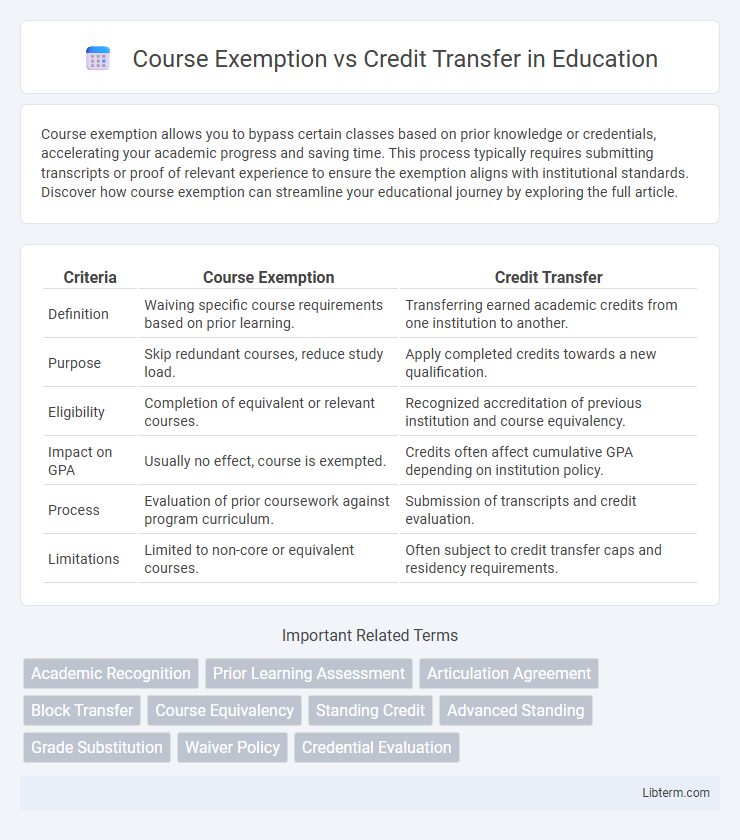Course exemption allows you to bypass certain classes based on prior knowledge or credentials, accelerating your academic progress and saving time. This process typically requires submitting transcripts or proof of relevant experience to ensure the exemption aligns with institutional standards. Discover how course exemption can streamline your educational journey by exploring the full article.
Table of Comparison
| Criteria | Course Exemption | Credit Transfer |
|---|---|---|
| Definition | Waiving specific course requirements based on prior learning. | Transferring earned academic credits from one institution to another. |
| Purpose | Skip redundant courses, reduce study load. | Apply completed credits towards a new qualification. |
| Eligibility | Completion of equivalent or relevant courses. | Recognized accreditation of previous institution and course equivalency. |
| Impact on GPA | Usually no effect, course is exempted. | Credits often affect cumulative GPA depending on institution policy. |
| Process | Evaluation of prior coursework against program curriculum. | Submission of transcripts and credit evaluation. |
| Limitations | Limited to non-core or equivalent courses. | Often subject to credit transfer caps and residency requirements. |
Understanding Course Exemption and Credit Transfer
Course exemption allows students to bypass specific course requirements based on prior learning or qualifications, effectively reducing the total number of courses needed for graduation. Credit transfer involves the recognition of previously earned academic credits from another institution, enabling students to apply these credits toward their current degree program. Both processes streamline academic progression by acknowledging existing knowledge and minimizing redundant coursework.
Key Differences Between Course Exemption and Credit Transfer
Course exemption allows students to skip specific courses based on prior learning or qualifications, while credit transfer grants recognition of completed coursework from another institution towards degree requirements. Course exemptions reduce the number of courses needed within a program, whereas credit transfers contribute equivalent academic credits that count towards graduation. Both mechanisms streamline academic progression but differ in scope, eligibility criteria, and impact on curriculum completion.
Eligibility Criteria for Course Exemption
Eligibility criteria for course exemption typically require students to have completed equivalent courses at an accredited institution with a minimum grade that meets the receiving institution's standards. Detailed course syllabi, learning outcomes, and official transcripts must be submitted for evaluation to verify content alignment and academic rigor. Each university or program may have specific cut-off grades, accreditation requirements, and time limits on prior coursework to qualify for exemption.
Eligibility Requirements for Credit Transfer
Eligibility requirements for credit transfer typically include a minimum grade threshold, often a C or higher, in the original course and alignment of course content between the previous institution and the receiving one. Applicants must provide official transcripts and detailed course descriptions or syllabi to demonstrate equivalency. Many universities also require that the credits be earned within a certain time frame, usually within the last five to seven years, to qualify for transfer.
Application Process for Course Exemption
The application process for course exemption requires submitting official transcripts, detailed course syllabi, and learning outcomes to the academic advisor or registrar's office for evaluation. Applicants must complete a formal exemption request form, often accompanied by a personal statement explaining the relevance of prior coursework to the current curriculum. Timelines and specific documentation vary by institution, making early consultation with academic departments essential for a successful course exemption application.
How to Apply for Credit Transfer
Applying for credit transfer requires submitting official transcripts from previous institutions along with detailed course descriptions to the target school's admissions or registrar's office. Students must complete the credit transfer application form, ensuring all supporting documents align with the credit transfer policies of the receiving institution. Approval depends on course equivalency, accreditation status, and the institution's specific guidelines for recognizing prior learning.
Documents Needed for Exemption and Transfer
Course exemption requires official transcripts, detailed course syllabi, and assessment evidence to validate prior learning against the new program's curriculum. Credit transfer demands authenticated academic records, course descriptions, and often completion certificates to ensure credits align with the receiving institution's standards. Both processes may also require formal application forms and approval letters from academic advisors or registrar offices.
Academic Impact of Course Exemption vs Credit Transfer
Course exemption allows students to bypass certain courses based on prior learning, which can accelerate degree completion and reduce tuition costs but may limit exposure to foundational knowledge. Credit transfer involves recognizing previously earned credits from another institution, preserving academic progress while maintaining curriculum integrity and degree quality standards. Both strategies significantly impact academic pathways, with exemption potentially affecting depth of learning and credit transfer ensuring continuity in academic records.
Pros and Cons of Course Exemption and Credit Transfer
Course exemption allows students to skip prerequisite courses based on prior learning, reducing study time but may limit exposure to foundational knowledge necessary for advanced subjects. Credit transfer enables recognition of completed coursework from other institutions, facilitating academic progression and potentially lowering tuition costs; however, it can create challenges in curriculum alignment and may result in loss of course credits if not fully compatible. Both options require careful consideration of accreditation policies to maximize educational benefits while minimizing academic gaps.
Common FAQs About Exemption and Credit Transfer
Course exemption allows students to skip certain subjects based on prior learning, while credit transfer involves moving earned academic credits from one institution to another. Common FAQs address eligibility criteria, required documentation such as transcripts or syllabi, and how exemptions or transfers affect graduation timelines. Students often ask about the difference in processing times and whether exemptions impact GPA calculation compared to credit transfers.
Course Exemption Infographic

 libterm.com
libterm.com